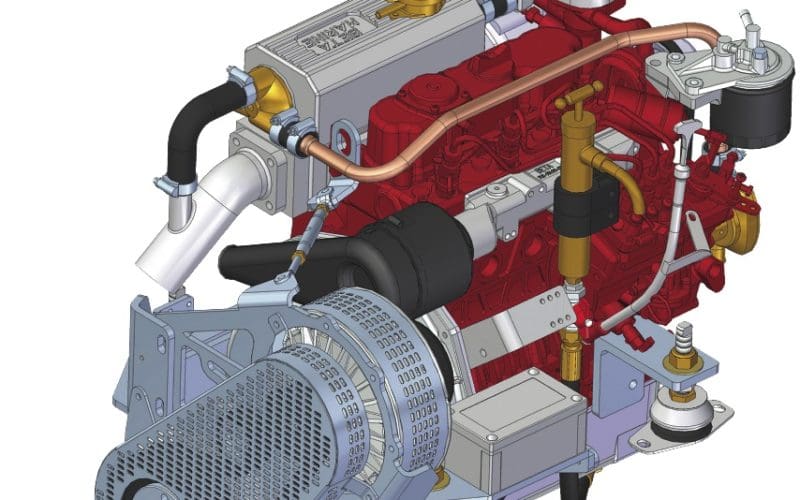As electric and hybrid cars gain wider acceptance on the road, electric and hybrid drives are also gaining a foothold in the boating world. At the recent Annapolis Sailboat Show this past October, for example, Hunter Marine introduced an all-electric auxiliary sailboat, the Hunter 27e, while Beta Marine displayed a diesel-electric hybrid engine designed to be plug compatible with a standard small diesel. These are just two examples of what seems to be an increasing acceptance of electric and hybrid power systems.
The Hunter 27e looks like any other 27-foot auxiliary sailboat, except for the “e” and the green leaf painted on the hull. Those telltale signs indicate an electric motor perched where ordinarily you’d find the standard small diesel engine. The 27e comes equipped with an EP-1000 electric motor from Elco Electric Propulsion Systems. The EP-1000 is a 10-hp AC motor with a maximum operating RPM of 2,100. It can accept DC voltages up to 72 VDC. The motor is fully enclosed, is splashproof and will continue to operate for a short time even when fully submerged (a reassuring thought about an unpleasant situation). The Elco unit takes DC power from the batteries and inverts it to AC within a motor controller unit. Because of this, a separate inverter is not required. According to Elco, the AC motor is better suited to the saltwater environment than a DC motor. “Not only is the AC motor more efficient, about 93 percent, but it is easier to make the AC motor waterproof,” said Peter Houghton, operations manager for Elco. “We can use epoxy to seal the interior parts and there are just two moving parts, the two bearings, so it works better when sealed up compared to a DC motor which has a fan and brushes that can get wet and corrode.”
As for batteries, standard equipment on the Hunter 27e is six 12-volt AGM batteries for a total of 214 amp hours. The batteries have to be charged to run the motor, so Hunter offers an optional package that includes solar panels and a wind generator. The Hunter 27e shows a commitment from a major boatbuilder to offer an alternative to the standard diesel auxiliary package. Will other boatbuilders follow suit?
Hybrid drives are also being offered by marine equipment suppliers. One diesel engine supplier, Beta Marine of Minnesott Beach, N.C., has partnered with a company called Hybrid Marine of Sandown on the Isle of Wight in the U.K. to produce a hybrid diesel solution. The Beta Marine Hybrid System uses a diesel engine connected to a 10-kW generator/motor.
When it comes to hybrid drives, there are basically three ways to set up a system: 1) diesel/electric, 2) a serial hybrid and 3) a parallel hybrid.
The diesel/electric approach uses a diesel generator that is electrically connected to the electric motor that drives the prop. But there is no direct mechanical link to the prop.
A serial hybrid also has the diesel disconnected from the prop, but the difference from a diesel/electric setup is that batteries are used for power when appropriate.
A parallel hybrid, however, is the most flexible of the three. It can either use the diesel to drive the prop directly or be disconnected from the prop shaft and use batteries to run the electric motor to spin the prop. Or, oddly enough, both the diesel and the electric motor can be used together to turn the propeller.
Parallel hybrids also allow you to disengage the prop while at anchor and mechanically spin the electric generator/motor, thus producing power like a genset.
Then there is the European research and development effort headed by marine writer and engineer Nigel Calder. A consortium of companies are investigating hybrid power systems for boats. Members of the consortium include Malö Yachts in Sweden, Steyr Motors of Austria, Mastervolt of the Netherlands, EnerSys of Switzerlan, Bruntons Propellers of the U.K. and INSEAN of Italy.
Even though we tend to think of hybrid setups primarily for moving the boat around, Calder says, “the benefit of these systems is not so much for propulsion but the real gains are for boats with high house loads.” A well-designed hybrid system provides you with considerable electrical power when you need it for things other than propulsion. “In a hybrid system you have a lot more electrical power readily available,” Calder said. “And you’re making electricity more efficiently than a conventional system.”
When you look at hybrid drives in terms of propulsion, according to Calder, one of the interesting aspects is getting a prop’s performance curve and an electric motor’s output curve to match up. In many cases, props and electric motors haven’t been well matched in the past. “There is an enormous amount of improvement to be made at the prop,” said Calder. “In matching the motor to the prop, you see real gains [in efficiency].”

